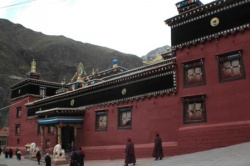Kingdom of Derge
The Kingdom of Derge was an important kingdom in Eastern Tibet from the 15th to the 19th century.Template:Citation needed It was a center of industry, religion and politics, with the seat of its kingdom in the town of Derge.[1] The kings of Derge followed a 1300-year lineage.[1]
At its height, the population of the kingdom consisted of 12,000 to 15,000 families.[2] The northern border of the kingdom was defined by Qinghai Lake; on the east, the boundary terminated at those states that utilized the Horpa variation of the Rgyalrongic languages, Chantui and Litang; the southern and western boundaries were defined by Batang, Sanai, Gonjo and Draya; and Lhato and Ch'amdo, respectively.[2]
The kingdom was known for its metal working and was an important center in the establishment of the Rime movement in Tibetan Buddhism.[3][4] The royal family of Derge were known as supporters of art, producing such artists as Situ Panchen, the kingdom's senior court chaplain, who is also known for his contributions to medicine and religion.[5][6] Regent Queen Tsewang Lhamo (d. 1812) was known for her support of printing and publishing.[7][8]
History
Derge became the capital of the kingdom in the 15th century under the reign of Lodro Tobden, the 31st in the line of the Derge kings.[9] It was he who invited Thang Tong Gyalpo to establish the renowned Gongchen Monastery in the region.[9] The kingdom expanded during the 18th century under the reign of Tenpa Tsering, who conquered territories to the north.[9]
In 1727, the Kingdom of Derge and other regions in Eastern Tibet fell under the governance of China. It is linked with others of the "more important districts", as Spencer Chapman termed them, such as Nyarong, Batang, Litang, and the five Hor[pa] States under the name "Kham", which Chapman describes as "an indefinite term suitable to the Tibetan Government, who are disconcertingly vague over such details as treaties and boundaries."[10] In 1733. The Yongzheng Emperor granted the king of Derge status of Hsuan Wei Ssu, a high position for native chieftains which effectively permitted him independence, though he was responsible for paying tribute.[11] In spite of the change of provenance, the kings of the region continued their internal struggles, and in 1863, rule of the kingdom was disrupted for two years by the successful invasion of Nyarong.[9] Intervention by the army of Tibet restored the kingdom, following a brief intermediate governance.[9]
In the early 1900s, Eric R. Coales prepared a report that included information about the "recent" history of the kingdom for the British.[12] According to Coales' report, in 1895, the Governor-General of Szechuan sent forces into Chantui, led by General Chang Chi, who advanced further into Derge.[13] The king and his family were imprisoned in Chengdu.[11] By the time political intrigue in China had forced the troops to withdraw, the king had died, leaving behind two sons, Doje Senkel and Djembel Rinch'en. The former of these enjoyed the support of the Chinese, but the latter, who may have been illegitimate, had backers in Chantui. The two struggled over the throne until 1908, when Doje Senkel appealed for assistance to the Chinese General Chao Eh-Feng, who was on military campaign in the area to secure the political primacy of China.[11] Djembel Rinch'en was driven to take sanctuary with the Dalai Lama, Thubten Gyatso; Doje Senkel yielded the kingdom to China in exchange for an allowance.[14] The Chinese retained direct control of Derge until 1918.[9]
The palace of the Derge kings was subsequently converted into a school.[15]
Footnotes
- ↑ 1.0 1.1 Template:Cite book
- ↑ 2.0 2.1 Template:Cite book
- ↑ Template:Cite book
- ↑ Template:Cite book
- ↑ Template:Cite book
- ↑ "Situ Panchen: Creation and Cultural Engagement in 18th-Century Tibet". Rubin Museum of Art. http://www.rmanyc.org/programs-events/situ-panchen.xml?context=programs-events/situ-panchen.xml. Retrieved 2009-02-15. Template:Dead link
- ↑ Template:Cite conference
- ↑ Template:Cite encyclopedia
- ↑ 9.0 9.1 9.2 9.3 9.4 9.5 Template:Cite book
- ↑ Chapman, F. Spencer. (1940). Lhasa: The Holy City, p. 135. Readers Union Ltd., London.
- ↑ 11.0 11.1 11.2 Coales, 224.
- ↑ Coales, 202.
- ↑ Coales, 222-223.
- ↑ Coales, 224-225.
- ↑ McCue, 241.
